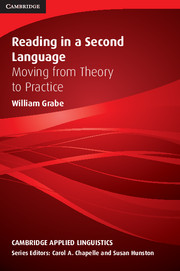Book contents
- Frontmatter
- Contents
- Series editors' preface
- Preface
- I FOUNDATIONS OF READING
- Chapter 1 The nature of reading: Defining reading
- Chapter 2 How reading works: The building blocks of fluency and comprehension
- Chapter 3 How reading works: Comprehension processes
- Chapter 4 Cognitive issues in reading
- Chapter 5 Models and more models of reading: Explaining reading
- II PATTERNS OF VARIATION IN READING
- III DEVELOPING READING COMPREHENSION ABILITIES
- IV EXPANDING READING COMPREHENSION SKILLS
- References
- Author Index
- Subject Index
Chapter 1 - The nature of reading: Defining reading
from I - FOUNDATIONS OF READING
Published online by Cambridge University Press: 05 August 2012
- Frontmatter
- Contents
- Series editors' preface
- Preface
- I FOUNDATIONS OF READING
- Chapter 1 The nature of reading: Defining reading
- Chapter 2 How reading works: The building blocks of fluency and comprehension
- Chapter 3 How reading works: Comprehension processes
- Chapter 4 Cognitive issues in reading
- Chapter 5 Models and more models of reading: Explaining reading
- II PATTERNS OF VARIATION IN READING
- III DEVELOPING READING COMPREHENSION ABILITIES
- IV EXPANDING READING COMPREHENSION SKILLS
- References
- Author Index
- Subject Index
Summary
We were never born to read. Human beings invented reading only a few thousand years ago. And with this invention, we rearranged the very organization of our brain, which in turn expanded the ways we were able to think, which altered the intellectual evolution of our species.
(Wolf, 2007: 3)Reading is something many of us take for granted. We read with what appears to be little effort and little planning. And it is remarkable that so much of the world's population can read – a little more than 80 percent of the world's population can read to some extent (Elley, 2001; Tucker, 2000; UNESCO, 2007). They can read basic forms, read advertisements, read newspapers, and use basic reading skills in their work and daily lives when needed. Some percentage of these people can read at a much higher level of comprehension, learning new conceptual information from texts, synthesizing new information from multiple texts, critiquing information in texts, and using their comprehension skills to reinterpret texts (Elley, 1992; Kirsch et al., 2002; NAAL, 2005; NAEP, 2007). Universal literacy is an ideal goal that is an ongoing priority among UNESCO, nation states, and many nongovernmental organizations, and efforts need to be made to reduce illiteracy levels.
It is also important to recognize that many people around the world read in more than one language. Large populations of people have learned to read in second or third languages for a variety of reasons, including interactions within and across heterogeneous multilingual countries, large-scale immigration movements, global transportation, advanced education opportunities, and the spread of languages of wider communication.
- Type
- Chapter
- Information
- Reading in a Second LanguageMoving from Theory to Practice, pp. 4 - 20Publisher: Cambridge University PressPrint publication year: 2008

